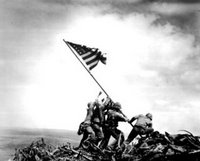ONE SHOT AT FAME
 Joe Rosenthal, the guy who snapped the famous shot of the five Marines & one sailor raising the US flag over Mt. Suribachi on Iwo Jima, died yesterday at 94. It's a famous photo, and Rosenthal gained lifelong fame for it. Hard to argue.
Joe Rosenthal, the guy who snapped the famous shot of the five Marines & one sailor raising the US flag over Mt. Suribachi on Iwo Jima, died yesterday at 94. It's a famous photo, and Rosenthal gained lifelong fame for it. Hard to argue.What I've always found fascinating about the story, though, are some of the misconceptions surrounding it. The facts: Marines invaded Iwo Jima on February 19, 1945, finally capturing the tactically-essential peak of Mt. Suribachi on February 23, after four days of intense combat. It was at this point that Rosenthal captured the famous image.
But . . . this was the second flag-raising on that sight, the first flag deemed too small, too hard to see from the beach below the peak. And Rosenthal also took another photo on that beach later in the day, in a completely posed shot. But the famous picture, while the second of two flag-raisings on that spot, was impromptu. Rosenthal wasn't working with the Marines. His open admission that the shot on the beach (the so-called "Gung-ho" shot) was posed only added to the longtime legend that the flag-rasing shot was as well.
But the most commonly-held misconception is also the most bittersweet: the taking of Mt. Suribachi didn't represent the culmination of the battle, anymore than taking Iwo Jima meant the War in the Pacific had ended (the slaughter on Okinawa was still to come). Following the tactical victory on Mt. Suribachi, the Battle for Iwo Jima raged on until well into March.
Which leads me to the saddest of all the misconceptions: of the six men pictured in that most-famous of WWII photos, three of them didn't leave the island of Iwo Jima alive. Both the leader of the unit and the fellow at far right (who famously squats down, straining to direct the flag pole into the ground) failed to survive the week, while the third was killed by a sniper late in the battle as the Marines were well into their "secure the island" phase.
The photo became -- and remains -- a symbol of victory. A testament to the efforts of the regular guys who invaded island-after-island in the Pacific, procuring them at enormous cost. And somehow, I find especially powerful symbolism in the twin facts of the photo: it captured that important victory, yet half of the men in that most famous of pictures didn't live long enough to revel in their fame, or even see the victory the photograph came to represent.
2 Comments:
Well said.
One of them was a sailor who died not too long ago.
Semper Fi to all of them.
Post a Comment
<< Home